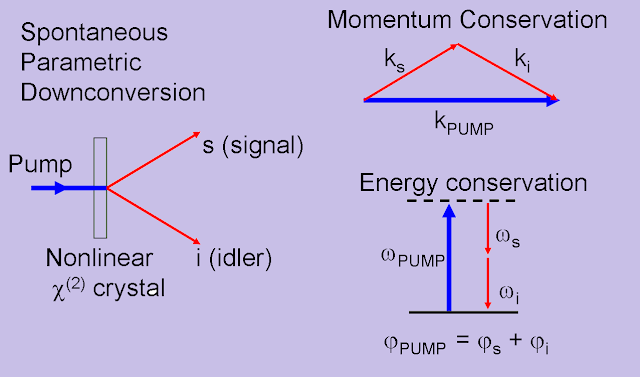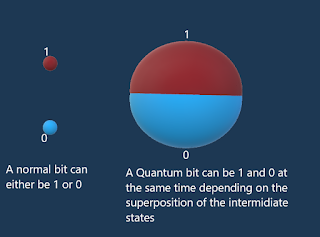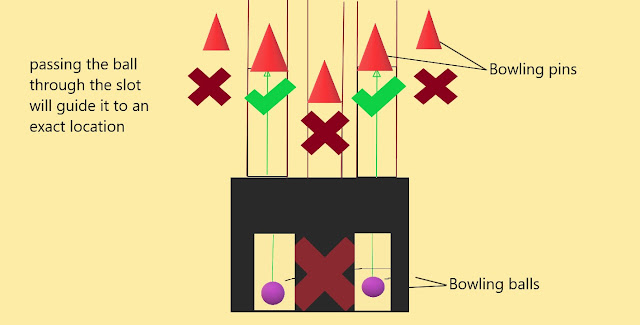What is quantum entanglement?
Quantum mechanics hasn't stop surprising me with what possibilities it can bring to the world, It's the key that opens the gate to the realm of science fiction and today I am going to talk about one of the strangest things in quantum mechanics, it's so bizarre that it is kind of spooky !!
Let's start with the basics, from a technique called "the spontaneous parametric down conversion", sounds complicated, doesn't it? But save your panic for later!
The experiment consists of passing a beam of light with an energy Ep=h.ωp through a nonlinear crystal. The crystal scatters the beam creating two other beams having different frequencies ωs and ωi. Based on the laws of energy conservation the combined energy of the 2 scattered rays should be equal to the energy of the incident ray so Ep=E1+E2=h(ωs+ωi).
The other interesting feature about this type of crystal is that it changes the light polarisation by an angle of 90°, so as usual let's consider two separate cases:
1- If an incident beam is polarised horizontally, meaning that the wave is horizontal then by passing it through the crystal we get two sets of photons (2 rays) vertically polarised and vice versa.
2- If we put two parallel crystals the polarisation will sum up and the input will be a diagonal light, but in fact, we don't get photons that are polarised diagonally, contrariwise, we obtain vertical or horizontal light depending on which crystal has dealt with the incident beam and here things will get much much interesting.
Quantum mechanics is based on uncertainty it's the science of studying random things, it is rather philosophical so if a diagonal polarisation is a mixture of vertical and horizontal lights then the question is: Which crystal did affect the incident light?
The answer is we can't, it is so random and there is no way to determine the output or attribute any result to one of the two crystals.
This is famously known as the entangled state. Don't worry I'll try to simplify it as much as I could.
The entangled state is a superposition of two eigenstates that can be written this way:
|𝚿〉=|HH〉+ |VV〉
Let's make this easier by referring to electrons: You should already know that it is impossible to determine the electron's position exactly because it is a superposition of many places at the same time so the wave function of an electron is |𝚿〉=|1〉+|2〉+|3〉+|4〉+|5〉+...+|n〉where n represents all the possible places that the electron could be within the orbital.
Besides, you should also know that to solve this equation we have to conduct an active measurement which allows us to know where the electron is at that specific moment. For example, if the electron happens to be in the 76th position the superposition collapses and we get |𝚿〉=|76〉, all the other possibilities become zero and we get a unique and certain solution.
So let's go back to our experiment; Case 2 shows that there are two possible occurrences, whether the first crystal polarises the incident beam into two daughter horizontal beams or the second crystal ( I forgot to say that it is just like the first crystal but it is perpendicular to it that's why it polarises vertically) polarises it into 2 vertical beams and based on the formula |𝚿〉=|HH〉+ |VV〉we can make a very intriguing conclusion.
Let's consider the case where we measure one of the two outcoming lights, therefore we can know the state of its corresponding photon and determine whether it's polarised vertically or horizontally and let's say the result was an H. Here begins the magic because this means that the incident light has sudden its transformation from the first crystal and in consequence, the other outcoming light is also polarised horizontally.
What I am trying to say is that we need to know one single eigenstate to determine the other: HH or VV.
This is why we call this phenomenon entanglement, it's like the two particles are somehow able to communicate a hidden information between them.
If you're not yet convinced I'll give another example that concerns the previous article about spins.
Some of the interesting features of electrons is that they obey the Paul exclusion principle which states that two identical fermions ( half integer spin ) are unable to occupy the same quantum state.
Knowing that the quantum numbers n, l and m define a basic orbital and that this particular orbital needs to contain a pair of electrons that are not identical, then the only possibilities for these electrons is to have different angular momentums, thus different sign of spin (-1/2 1/2) or easier to say one is up and the other is down. (🠅🠇). So there are two possibilities, either the first electron is up and the other is down or vice versa.
The wave function then is a superposition of two possible states:
|𝚿〉=|🠅🠇〉+ |🠇🠅〉
In this case, if we manage to know the state of one electron then by elimination the other state is determined automatically and we can say that the pair is entangled.





Comments
Post a Comment